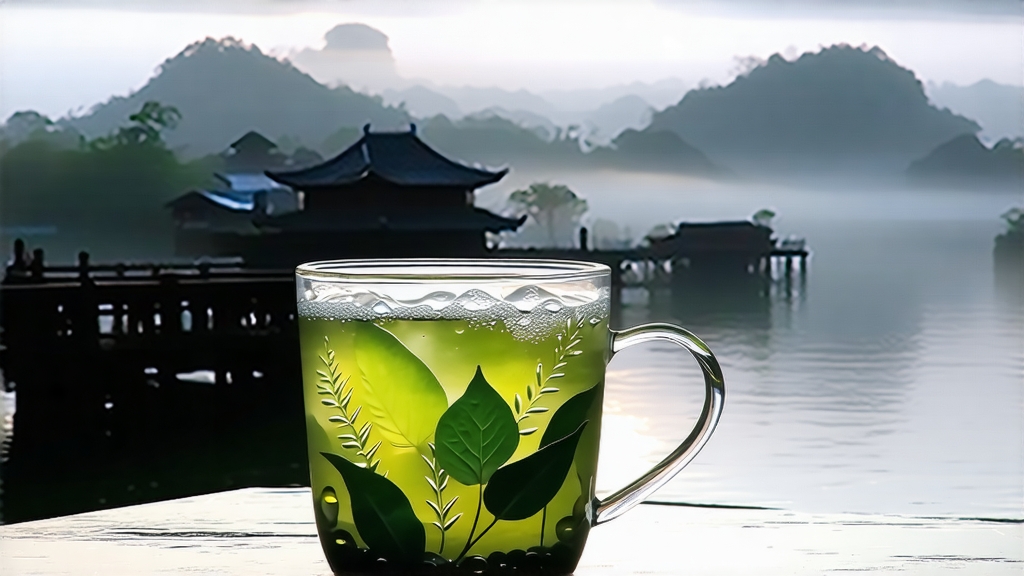
Longjing—often spelled Lung Ching in older Western texts—is not merely a tea; it is a liquid manuscript of Chinese civilization. When the first spring rays touch the terraced gardens that rim West Lake in Hangzhou, Zhejiang province, the year’s most coveted green tea begins its short, fragrant life. For thirteen centuries these gently sloped hills have produced a leaf so revered that emperors built vacation palaces nearby simply to secure the earliest harvest. Today the same hills attract pilgrims of taste who arrive before Qingming festival, hoping to witness the forty-eight-hour window when one bud and one unfolding leaf contain the ideal balance of amino acids, polyphenols and springwater sweetness.
History whispers through the pine-shaded paths. The name “Dragon-Well” derives from a spring whose dense, mineral-rich water resembles a coiled dragon when stirred. Song-dynasty monks first planted tea bushes around the spring in the 10th century, but the leaf gained imperial status under the Qianlong Emperor of the Qing. Folklore claims that Qianlong, while visiting the south in 1751, became so enamored of the pluckers’ songs that he pocketed a handful of fresh shoots. Later, pressed for time, he entrusted the leaves to a local monk who pan-fired them in an iron wok. The emperor declared the resulting brew “sweet enough to rinse the heart,” and Longjing entered the pantheon of tribute teas, a status it held until the fall of the dynasty in 1911.
Modern classification divides Longjing into six ecotypes, yet only three enjoy protected-origin status. Xihu Longjing, grown within the original West Lake microclimate, remains the benchmark: orchid-like fragrance, sword-shaped leaves, and a lingering bean-cream finish. Qiantang Longjing, cultivated along the Qiantang River, offers a slightly bolder, nuttier cup. Yuezhou Longjing, from the hills of Shaoxing, trades delicacy for briskness and value. Beyond these lie the “Zhejiang Longjings,” pleasant teas grown elsewhere in the province, but lacking the shale-and-quartz terroir that concentrates amino acids in the leaf. Discerning buyers look for the tiny lion-emblem seal on tins; without it, the tea inside is probably a cousin, not a sibling.
The craft that converts leaf to legend has changed less than the dynasties themselves. Picking begins at dawn when dew still pearls the rows, because sunlight raises leaf temperature and accelerates enzymatic oxidation—anathema to green tea. Experienced pluckers use a three-finger twist that snaps the stem without bruising; any tear releases juices that oxidize and dull the liquor. By nine o’clock the wicker baskets arrive at the village threshing floor where “tea professors”—a title earned only after ten seasons—judge moisture content by pressing a fistful against the cheek. If the leaves spring back slowly, they are ready for the most cinematic stage: hand-firing in seasoned iron woks.
Each wok is heated to exactly 180 °C by burning local pine. A professor swirls a bamboo brush to test the surface, then in one motion tosses in 250 grams of leaf. For the next fifteen minutes the air fills with the scent of warm spinach and toasted rice. Using only bare hands protected by years of callus, the maker performs ten distinct motions: tug, press, rub, shake, toss, flick, roll, pat, lift, smooth. The goal is to drive off 30 % moisture while locking in the flat, jade-green shape that resembles the tip of an ancient sword. When the leaf temperature drops to 60 °C the wok is recharged, and the cycle repeats—often three times—until the leaves feel “like dry paper but smell like fresh rain.” No thermometer intrudes; the palm is the only instrument trusted.
Mechanization has made inroads—conveyor belts now mimic the hand motions—but the finest lots remain stubbornly manual. A single master can finish only two kilograms per day, roughly enough to fill eighty 25 g tins. That scarcity explains why pre-Qingming Xihu Longjing retails above two thousand yuan per 500 g, and why counterfeiters flatten cheaper leaves with cement rollers, dye them with chromium oxide, and scent them with artificial chestnut essence. Authentication therefore begins with the eyes: authentic leaf is olive, not neon; it lies perfectly flat yet springs back when bent; and it carries a